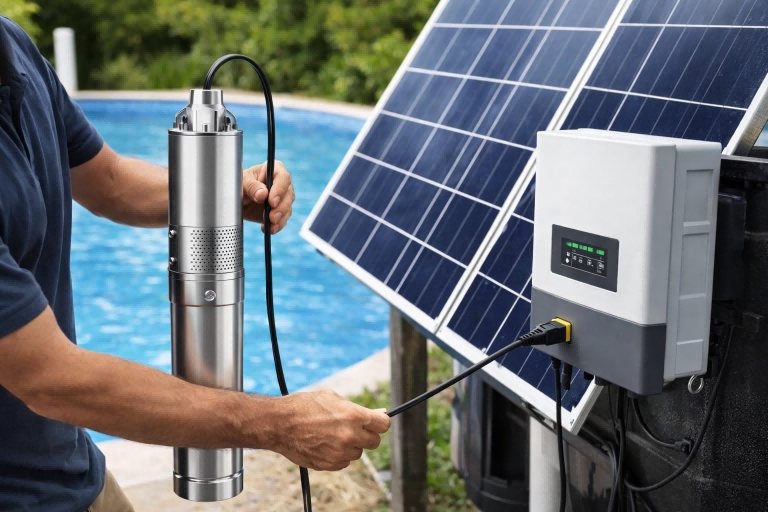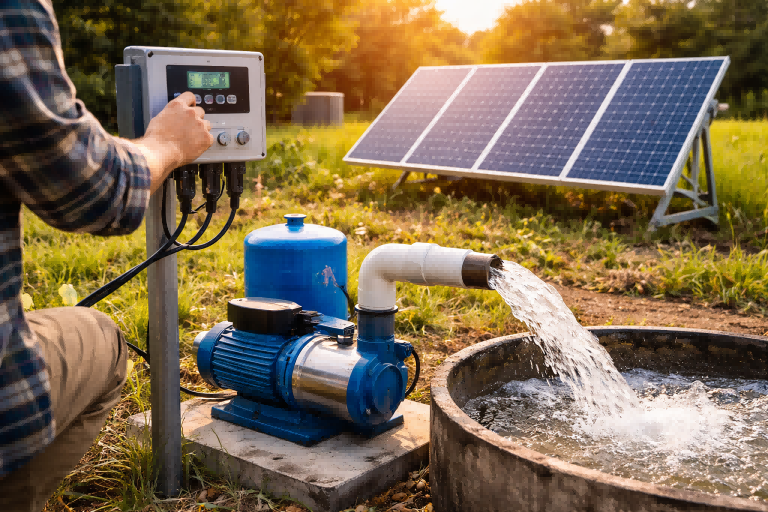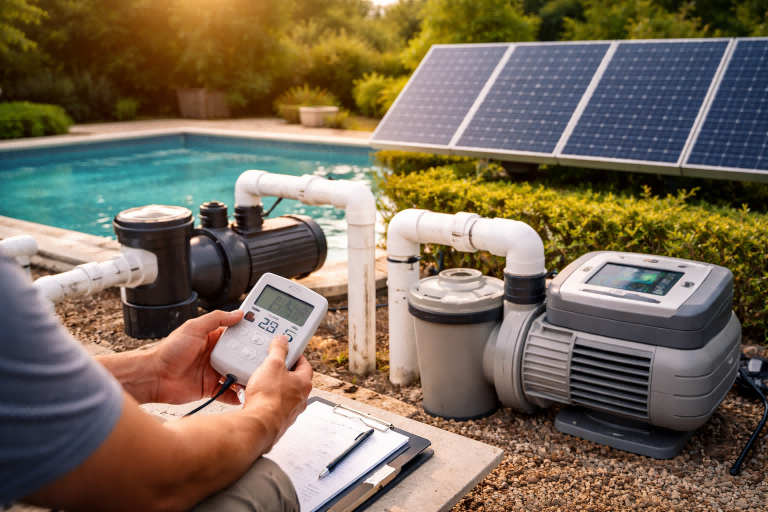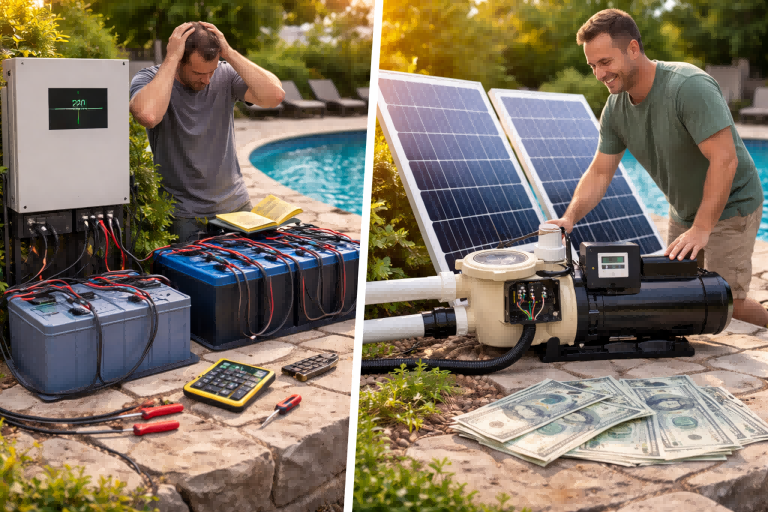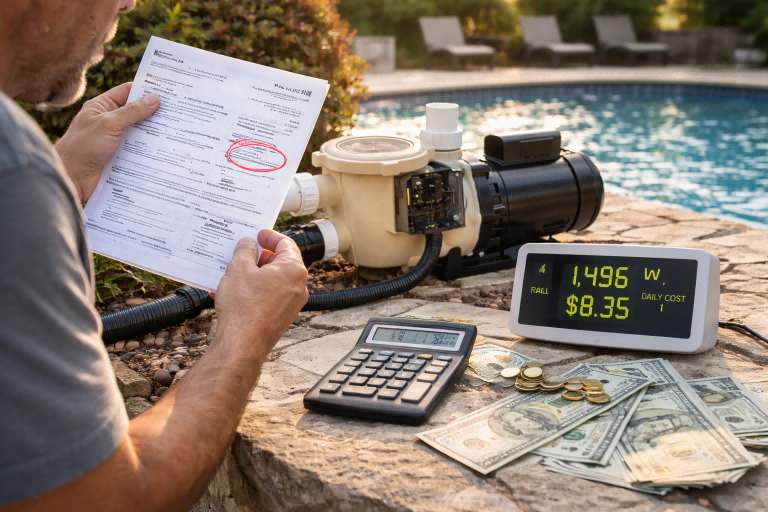Are you tired of relying on an unstable power grid and facing ever-increasing electricity costs?
This dependence makes your water supply vulnerable.
A solar pump provides a path to true independence.
A solar pump gets you off the grid by creating a self-sufficient system.
It uses photovoltaic panels to generate its own electricity from sunlight, powering the pump directly without needing any connection to the utility network. This ensures you have water whenever the sun shines.
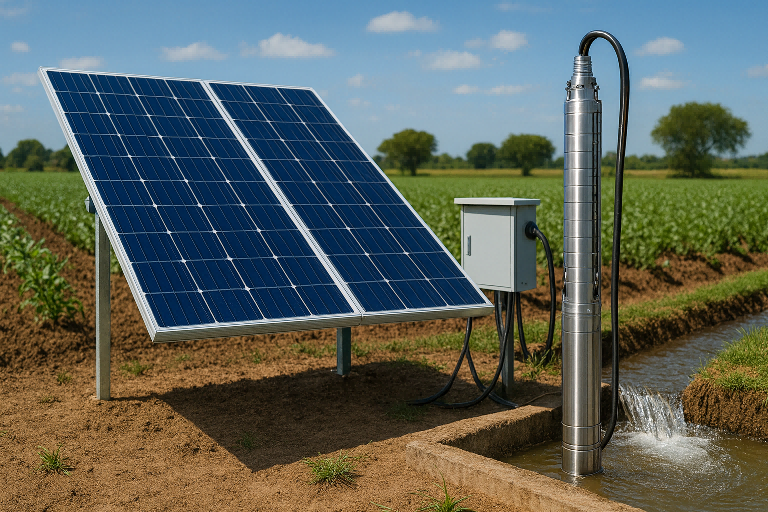
This off-grid capability is not magic.
It is the result of a perfectly integrated system.
Each component is designed to work in harmony, powered solely by a free and abundant energy source.
Understanding how these components—the panels, the controller, the pump, and the storage method—come together is key to appreciating the resilience and freedom this technology offers.
Let's dive into the mechanics of how a solar pump can completely sever your ties to the grid for good.
1. Generate Your Own Power with Photovoltaic (PV) Panels
Is there no grid power where you need water?
Extending power lines for kilometers is incredibly expensive.
You need a reliable power source right where the work is done.
Photovoltaic (PV) panels are the foundation of an off-grid solar pump system.
They convert sunlight directly into DC electricity.
This creates an independent power station precisely where you need water, completely eliminating the need for a grid connection.
The first and most fundamental step to getting off the grid is creating your own source of power.
For a solar pump, this source is a solar array composed of PV panels.
These silent, solid-state devices are your personal power plant, harnessing the sun's energy to do the work of moving water.
Their design and sizing are critical for a successful off-grid system.
How PV Technology Works
The process of converting sunlight into electricity is known as the photovoltaic effect.
It is a simple yet powerful principle.
- Sunlight Strikes: Photons from sunlight strike the surface of a solar panel.
- Electrons Are Excited: The panels are made of semiconductor material, usually silicon. The energy from the photons knocks electrons loose from their atoms.
- Current Is Created: An internal electric field within the panel's cells forces these freed electrons to flow in one direction. This flow of electrons is a direct current (DC).
This DC electricity is then sent from the panels to the pump controller, ready to power the motor.
The Importance of Sizing Your Solar Array
A common mistake is incorrectly sizing the solar array.
An undersized array will not provide enough power to run the pump effectively, especially during peak demand.
An oversized array is a waste of money.
Proper sizing depends on three main factors:
- The Pump's Power Requirement: Measured in watts (W), this is how much power the pump needs to operate.
- Daily Water Needs: How many gallons or liters you need to pump per day determines the required daily runtime.
- Peak Sun Hours: This is not the total hours of daylight. It is the number of hours per day that the sun's intensity averages 1,000 watts per square meter. This value varies significantly by geographic location and season.
| Let's look at a basic sizing example: | Parameter | Value | Description |
|---|---|---|---|
| Pump Power Rating | 750 Watts | The power the pump motor consumes. | |
| Required Daily Runtime | 5 hours | The time needed to pump the required volume. | |
| Total Daily Energy Needed | 3.75 kWh | Calculation: 750 W * 5 h = 3,750 Wh. | |
| Local Peak Sun Hours | 5 hours | The average for the specific location. | |
| Minimum Array Size (Ideal) | 750 Watts | Calculation: 3,750 Wh / 5 h = 750 W. | |
| Realistic Array Size (+25%) | ~940 Watts | This adds a margin to account for system losses (wiring, heat, etc.). |
Types of Solar Panels
For your solar array, you will primarily choose between two types of common PV panels.
- Monocrystalline: Made from a single silicon crystal, these panels are more efficient and have a sleek, black appearance. They perform better in lower light and are ideal when space is limited.
- Polycrystalline: Made from multiple silicon fragments melted together, these have a blue, speckled look. They are slightly less efficient but are generally more affordable, making them a good choice for larger installations where space is not a concern.
2. The Smart Brain: The Solar Pump Controller
Connecting a pump directly to panels is a recipe for disaster.
Fluctuating sunlight can stall or damage the motor.
You need an intelligent device to manage and optimize this variable power.
The solar pump controller is the brain of your off-grid system.
It precisely manages the fluctuating DC power from the panels.
It also protects the pump motor and uses Maximum Power Point Tracking (MPPT) to dramatically boost water output.
The controller, sometimes called an inverter for AC systems, is the critical link between the power source (panels) and the load (pump).
Its role goes far beyond a simple on/off switch.
It is an advanced piece of power electronics that ensures the entire system operates with maximum efficiency, reliability, and longevity.
Without a quality controller, an off-grid pumping system is simply not viable.
Maximizing Every Sunbeam with MPPT
The single most important feature in a modern solar pump controller is Maximum Power Point Tracking (MPPT).
The voltage and current produced by a solar panel change continuously with sunlight intensity and temperature.
There is a specific combination of voltage and current (the "Maximum Power Point") where the panel produces its absolute maximum power.
- An MPPT controller is a smart DC-to-DC converter.
- It constantly measures the panel's output.
- It adjusts its internal resistance to keep the panel operating at this peak efficiency point.
This technology is not a minor tweak.
A system with MPPT can harvest up to 30% more power from the same solar array compared to a system without it.
This translates directly into more water pumped per day, especially during early mornings, late evenings, and on overcast days.
Intelligence and Protection
Beyond optimization, the controller acts as a dedicated guardian for the pump motor.
Pump motors are expensive, and a controller provides essential protective functions that are critical in an off-grid environment.
- Dry Run Protection: The most common cause of pump failure is running without water, which causes overheating. Controllers prevent this by monitoring motor load or by using input from water level sensors. If the well runs dry, the controller shuts the pump off automatically.
- Voltage and Current Protection: It protects the motor from overvoltage or undervoltage conditions that can occur with rapidly changing sunlight. It also prevents overcurrent situations that could burn out the motor windings.
- Soft Start Functionality: The controller gradually ramps up the motor's speed. This reduces the mechanical stress on the pump and the electrical strain on the system during startup.
DC vs. AC Pump Systems
The controller's design depends on whether it is running a DC or an AC pump.
- DC Systems: These are more common for smaller to medium-sized applications. The system is simple: DC power from the panels goes to a DC controller, which then powers a brushless DC pump motor. This setup is highly efficient as there is no need to convert the power from DC to AC.
- AC Systems: For very large pumps or when retrofitting an existing AC pump, a solar pump inverter is used. This device takes the DC power from the panels and inverts it into the AC power needed by the pump. While there are some energy losses in the DC-to-AC conversion, it allows for the use of powerful, commonly available three-phase AC motors.
3. Water When You Need It: Storage as a Battery
The sun does not shine 24/7.
What if you need water at night or on a rainy day?
Adding a large battery bank is expensive, complex, and adds a major maintenance liability.
For an off-grid solar pump system, your water tank is your battery.
By pumping water into a raised storage tank during sunny hours, you use the simple, free power of gravity to provide a consistent water supply 24/7, without the high cost of electrical batteries.
The key to off-grid success is autonomy.
You need a system that can bridge the gaps when the energy source—the sun—is not available.
While electronic batteries are one solution, a far simpler, more cost-effective, and longer-lasting method for water pumping is to store the product of the energy, not the energy itself.
This means storing water.
The Elegance of a Gravity-Fed System
The concept is a brilliant application of basic physics.
- Pumping Phase: During the day, when the sun is shining brightly, the solar pump is at its most productive. It pumps water from the source (a well, river, etc.) up to a large storage tank situated on higher ground or a tower.
- Storage Phase: The water sits in the tank, holding potential energy due to its height.
- Distribution Phase: Whenever water is needed—day or night, rain or shine—a valve is opened. Gravity then pulls the water down from the tank and distributes it to homes, livestock troughs, or irrigation lines.
This gravity-fed pressure is consistent and reliable.
It completely decouples your water access from the immediate availability of sunlight.
Sizing Your Water Storage
Just like the solar array, the storage tank must be sized correctly.
The main considerations are your daily water use and the number of "reserve days" you want.
A reserve day is a day of water supply you have in storage in case of extended cloudy weather.
A simple formula to start with is:
Tank Size = (Average Daily Water Consumption) x (Number of Reserve Days)
For example, if a small community uses 5,000 liters of water per day and wants a 3-day reserve, they would need a 15,000-liter tank.
Water Tank vs. Battery Bank: A Clear Winner
For pumping applications, storing water in a tank is almost always superior to storing electricity in batteries.
Here’s a direct comparison:
| Feature | Water Storage (Tank) | Battery Bank |
|---|---|---|
| Initial Cost | Low to Moderate | Very High |
| Lifespan | 20-30+ years | 5-15 years (requires replacement) |
| Maintenance | Virtually none | Regular monitoring, potential for failure |
| Complexity | Extremely simple mechanical system | Complex electrical system with charge controllers |
| Efficiency | Very high (minimal losses) | Moderate (energy lost in charging/discharging) |
| Environmental | Benign materials (plastic/steel) | Contains hazardous materials, disposal issues |
For these reasons, the vast majority of off-grid solar water pumping systems are designed to be "batteryless," relying on the simple and robust solution of a water tank.
4. The Heart of the System: The Efficient Solar Pump
Standard AC pumps are power-hungry beasts.
They are not designed for the variable DC power that solar panels produce.
Using one would be inefficient and waste your valuable solar energy.
The solar pump itself is purpose-built for efficiency with solar power.
Most modern systems use a brushless DC (BLDC) motor.
These motors are exceptionally efficient, durable, and perfectly suited to convert more of the sun's energy into the physical work of moving water.
The final piece of the off-grid puzzle is the pump itself.
This is where the electrical energy is converted into mechanical work.
The efficiency of this conversion is paramount.
In an off-grid system, every watt of power is precious.
You cannot afford to waste it on an inefficient motor.
That is why solar pumps use specialized motor technology designed for maximum output from minimal input.
Why Brushless DC (BLDC) Motors Are a Perfect Match
Brushless DC motors are the preferred choice for most solar pumping applications, particularly for submersible well pumps.
Their design offers several key advantages that make them ideal for solar power:
- High Efficiency: BLDC motors are significantly more efficient than their AC or brushed DC counterparts. They can convert over 85% of the electrical energy they receive into mechanical power, meaning less wasted energy and more water pumped.
- Exceptional Durability: As the name implies, they have no brushes. Brushes are carbon components that wear down over time in traditional motors, requiring replacement. By eliminating them, BLDC motors have fewer points of failure and a much longer, maintenance-free lifespan.
- Excellent Speed Control: The speed of a BLDC motor can be controlled very precisely by its electronic controller. This allows the pump to run effectively at various speeds, perfectly matching the fluctuating power output from the solar panels throughout the day. It will run slower in low light and faster in bright sun, maximizing runtime.
Permanent Magnet Synchronous Motors (PMSM)
For some larger AC solar pumping systems, Permanent Magnet Synchronous Motors are used.
These motors also offer very high efficiency and power density.
Like BLDC motors, they use powerful permanent magnets to create the magnetic field, which is more efficient than using copper windings like in a standard induction motor.
An advanced solar pump inverter can control a PMSM with great precision, making it another excellent choice for off-grid applications.
Matching the Pump Type to the Water Source
The motor is housed within a specific type of pump end, which must be matched to your water source to create a complete off-grid solution.
- Solar Well Pumps (Submersible): These are long, thin pumps designed to be lowered deep into a borehole or well. They are the most common solution for providing drinking water and irrigation in off-grid locations.
- Solar Surface Pumps: These pumps are located on dry land and are used to pull water from a shallow source like a pond, river, or storage tank. They are ideal for water transfer and booster applications.
- Solar Pool Pumps: An increasingly popular off-grid application. A pool's circulation and filtering needs align perfectly with the sun's schedule, making a dedicated, off-grid solar pool pump a simple and effective way to eliminate a major household electricity cost.
Conclusion
A solar pump gets you off the grid with four key elements.
PV panels create power, a controller optimizes it, a water tank stores the output, and an efficient pump does the work.
Frequently Asked Questions
How many solar panels does it take to run a water pump?
This depends on the pump's wattage and your location's sun hours. A small pump may need only 2-3 panels, while a large irrigation pump could require more than 20.
Can a solar pump run without batteries?
Yes, most do. They run directly from solar panels during the day and use a water storage tank to provide water at night, which is more cost-effective than batteries.
How deep can a solar water pump go?
Solar well pumps are designed for various depths. Models are available that can pump water effectively from wells that are hundreds of meters (over 1000 feet) deep.
Do solar pumps work on cloudy days?
Yes, but at a reduced flow rate. As long as there is some daylight, the panels will produce some power, and the pump will operate, just slower than in full sun.
What size solar pump do I need?
Sizing depends on your daily water requirement and the total dynamic head (the vertical distance you need to lift the water). A professional can help calculate the exact size.
Is a solar water pump a good investment?
Yes, it is an excellent long-term investment. While the initial cost is higher, it has virtually no running costs, leading to significant savings on fuel or electricity over its long lifespan.
Can you connect a solar panel directly to a pump?
It is not recommended. Connecting directly can damage the pump motor due to fluctuating voltage. A solar pump controller is essential to regulate the power and protect the pump.
What is the main difference between a solar pump and a normal pump?
The main difference is the motor and power source. A solar pump uses a highly efficient DC or specialized AC motor designed to run on variable power from solar panels.


